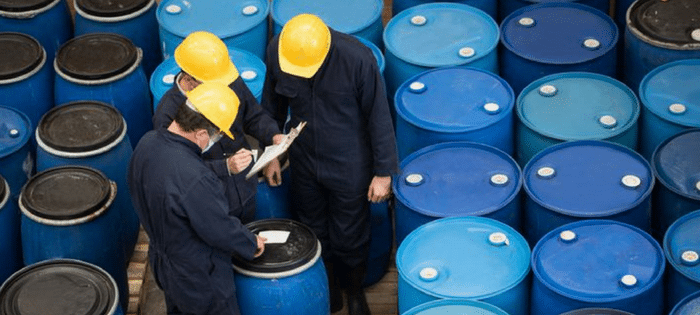
Environment
Comments: 1 Comment
An ever-growing area of concern across the industry is the appropriate management of hazardous materials and waste. The number of government regulations concerning hazardous materials handling alone is significant—from the U.S. Environmental Protection Agency (USEPA) and Occupational Safety and Health Administration (OSHA), to the Department of Transportation (DOT), Department of Homeland Security (DHS), Drug Enforcement Agency (DEA), and Nuclear Regulatory Commission (NRC). Under these laws, the disposal of hazardous material in the sewer system, stormwater system, on the ground, or in regular trash is regulated by a number of prohibitions.
In addition to these regulations, there are international codes for hazardous materials —developed by the International Fire Code (IFC)/International Building Code (IBC) and operationalized by local officials—that apply across the industry. Kestrel has found that more and more facilities, particularly those in retail warehousing, are being subjected to the requirements of these codes.
IFC/IBC Requirements
Local fire marshals have the responsibility to inspect facilities and ensure that hazardous materials are properly managed and stored. Although local requirements may vary, most local laws have closely adopted the IFC/IBC requirements for hazardous materials management.
The IFC/IBC requirements reference hazardous material as it relates to hazard classes—a significant difference compared to some of the other hazardous materials regulations across the U.S. Applicability and specific requirements are based on:
- Hazard class of the chemical
- Volume of the chemical
- How the chemical is used
- How the chemical is stored
- Building occupancy
Depending on these things, the local fire marshal may require the facility to develop a Hazardous Materials Management Plan (HMMP), conduct a Hazardous Materials Inventory, and/or submit a Hazardous Materials Permit.
HMMP Requirements
The purpose of a Hazardous Materials Management Plan (HMMP) is to describe the company’s procedures for storing, using, managing, and disposing of hazardous materials in a safe manner.
The information requested for an HMMP is different than that required for Tier II reporting under Section 312 of the Emergency Planning and Community Right-to-Know Act (EPCRA). The purpose of the Tier II form is to provide state and local officials and the public with information on the general hazard types and locations of hazardous chemicals at the facility.
Notable differences between Tier II and HMMP include the following:
- Classifications and regulations are different.
- Volumes that trigger an HMMP are much lower.
- Use and storage of the chemical, as well as the occupancy of the building, influence the requirements for an HMMP.
Beyond the HMMP, a company may need to conduct a Hazardous Materials Inventory, which requires defining hazard classes for chemicals at the facility and may need to apply for a Hazardous Material Permit under the authority of the local fire marshal.
While there may be variations by the local authority, in general, the Plan and Inventory include the following:
| Hazardous Materials Management Plan (HMMP) | Hazardous Materials Inventory |
|
|
Hazard Classes and MAQs
Hazard classes, as required in the Hazardous Materials Inventory, are listed in IFC Appendix E. They include physical hazards and health hazards, and typically have a number of associated subcategories. A hazard class is not listed on a Safety Data Sheet (SDS). The classes include:
- Explosives
- Compressed Gases
- Flammable and combustible liquids
- Flammable solids
- Combustible dust and powders
- Oxidizers
- Organic Peroxides
- Pyrophoric materials
- Unstable materials
- Water reactive materials
- Cryogenic materials
- Toxic materials
- Corrosives
The MAQ for a hazardous material will determine occupancy requirements and required controls (sprinkler systems, temperature controlled storage etc.). The MAQs are located in:
- IBC Table 307.1(1) and IFC Table 5003.1.1(1) for physical hazard hazardous materials
- IBC Table 307.1(2) and IFC Table 5003.1.1(2) for health hazard hazardous materials
- IFC Tables 5003.1.1(3) and (4) for outdoor control area MAQ
Note that the IBC and IFC are both involved to determine the hazard classification and the associated storage limits and requirements.
Moving Forward
Companies with hazardous materials must manage their hazardous materials safely. To ensure that they are meeting the IFC/IBC requirements, it is beneficial for companies to:
- Check with the local fire marshal to determine what needs to be done to meet local requirements, including engineering design requirements.
- Prepare and maintain a facility map identifying storage areas, sprinkler systems, emergency plans, etc. and document it in an HMMP.
- Contact vendors/installers of sprinkler systems and other equipment to ensure that the systems are designed for their intended use. The installer is a good resource for what would be allowed in a particular area and what the limitations of the system might be. This should be verified by qualified engineers.
- Conduct a Hazardous Materials Inventory, if required, to define hazard classes. This may require outside assistance to appropriately classify chemicals.
- Complete any special Hazardous Materials Permits, if required.
- Comply with the conditions of a Permit and with the technical specifications for activities such as maintenance; recognize and manage any changed conditions.
- Regularly inspect and audit the systems for compliance.
Managing hazardous materials is a part of doing business safely. Satisfying local fire marshal requirements will further help ensure that the company, the environment, and the surrounding community remain unharmed.

Thanks for explaining that items can be classified as hazardous if they pose a physical or medical risk. Now that I think about it, I’d be interested to learn more about how these risks are controlled whenever hazardous materials have to be transported to a new location, which is probably fairly often. I enjoyed reading your article and learning more about classes of hazardous materials, so thanks for sharing! http://highqllc.com/hazmatpackagetestingservices.aspx